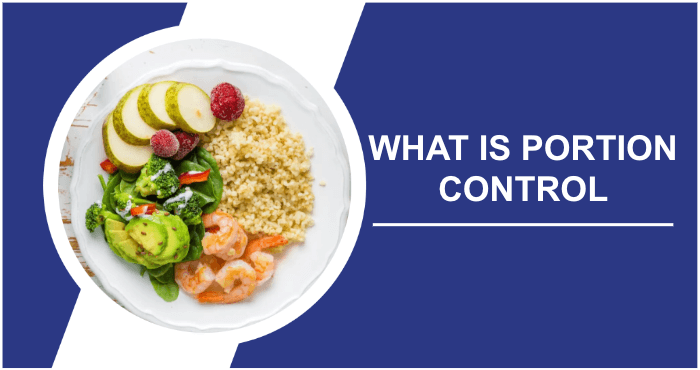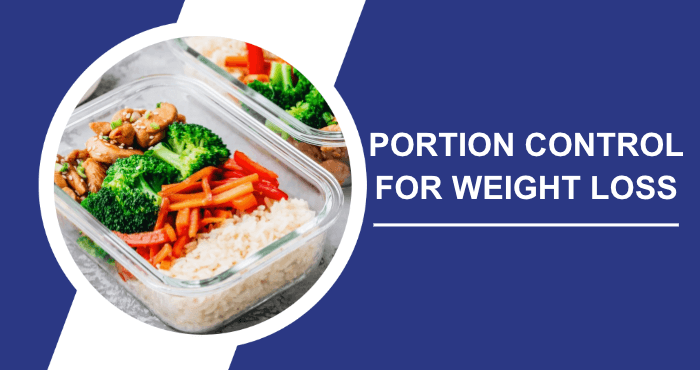Many people are aware that what we eat has a significant impact on the size of our waistline. But did you know that the amount of food we eat at each meal – and the frequency of our meals – also has a significant impact on our success in losing fat? In fact, we’ve learned that portion control is effective for weight loss, especially if we choose nutrient-dense superfoods and steer clear of highly processed options. However, sticking to a portion control diet isn’t easy (after all, our favourite snacks are often irresistible!).
In this article, we will reveal the science behind successful portion control to help you achieve and maintain your ideal weight. In addition, we will share our top strategies for managing portion sizes to help you reduce body fat and feel both healthier and happier. Together, these effective strategies will help you reduce body fat, increase energy levels and reach your weight loss goals faster!
6 Practical Suggestions For Portion Control When Losing Weight
- Eat breakfast
- Choose superfoods over sweeteners
- Keep hydrated by drinking water
- Avoid overloading your plate
- Emphasise quality chewing
- Increase meal frequency
How Effective Is Portion Control?
Portion control is highly effective for weight management and overall health. It helps regulate calorie intake, prevents overeating and encourages a balanced diet. By controlling portion sizes, people can enjoy a variety of foods without excess calories, which can contribute to sustainable weight loss and long-term health benefits.
6 Effective Portion Management Strategies For Weight Loss
The essence of eating right is choosing foods that are satisfying, enjoyable and low in calories. It’s about reducing your intake and increasing the frequency of your meals (an enjoyable approach, since your next meal is always around the corner). Drinking plenty of water and reducing the size of your utensils and crockery can also help you stay on track. Read on for more insights!
1. Eat Breakfast
Many studies have shown that skipping breakfast can often lead to obesity. So don’t skip it – opt for healthy, delicious options, such as an all-white omelette with spinach and cherry tomatoes on toasted multigrain bread. You’ll consume fewer calories than high-sugar cereals, feel fuller and reduce your chances of gaining weight in the future!
2. Prioritise Nutrient-Dense Foods Over Sweeteners
Studies show a clear link between the consumption of highly processed, fatty and sweet, high-calorie foods and the development of obesity and fat accumulation. In contrast, the consumption of nutrient-dense foods (characterised by high nutrient and antioxidant content, low calories and predominantly plant origin) contributes significantly to weight loss. These include vegetables, whole grains, seeds, quinoa, berries, salmon, soya and Brazil nuts. A varied selection increases satisfaction with meals, mainly due to their low glycemic index (the rate at which food releases energy).
In addition, fibre-rich choices such as kale aid digestion, while the natural protein and healthy fats in foods such as nuts and salmon help to prolong satiety. The low-calorie nature of most nutrient-rich foods allows for generous portions.
These foods are also known to reduce the risk of degenerative diseases and provide a concentrated supply of antioxidants, vitamins, minerals, fibre and other essential nutrients. If incorporating them into a balanced diet is difficult at first, starting with a small green salad as a starter is an effective tactic. This will immediately increase your fibre intake and help you feel fuller.
3. Keep Hydrated By Drinking Water
Drinking a glass of water before each meal helps with weight management by ensuring proper hydration. A recent study on obesity found a strong correlation between inadequate hydration and higher body mass index and the onset of obesity.
4. Avoid Oversizing Your Plate
Research shows the benefits of using smaller plates, cups and utensils rather than larger ones for better portion control when trying to lose weight. For example, research into the influence of plate size and portion control on children’s eating habits found that children consumed more when using adult sized plates.
5. Focus On Effective Chewing
The rate at which you eat your meals is often highlighted as a key element in controlling and preventing obesity. Eating at a slower pace not only increases the enjoyment of your meals, but also increases your sense of satiety. As a result, you are likely to maintain a lower body mass index over time.
6. Increase Your Meal Frequency
For those who don’t like strict diets, here’s some encouraging information. Research into meal frequency shows that increasing the number of meals you eat each day (from the usual three to six) has a significant effect on weight loss. This change also helps with glycaemic regulation, ensuring more stable blood sugar levels and reducing the likelihood of feeling hungry due to low blood sugar.
Finally, if you’re interested in a structured approach to weight loss and conscious eating, consider exploring different meal plans for additional support and guidance.
What Is Portion Control?

In the words of the Cambridge Dictionary, portion control is ‘ensuring that the amount of food consumed at each meal is not excessive, especially when trying to lose weight. Essentially, it means being able to eat a delicious breakfast, a healthy lunch or a sumptuous dinner that meets our calorie needs without adding excess calories. But why is this concept so important?
When Will I See Results?
With consistent portion control, you may start to see results within a few weeks, but this can vary greatly depending on your individual metabolism, starting weight, diet composition, level of physical activity and overall lifestyle. In general, a safe and sustainable rate of weight loss is around 1-2 pounds per week. Remember that portion control is most effective when combined with a balanced diet and regular exercise. It’s also important to listen to your body and consult a healthcare professional for personalised advice.
How Does Portion Control Help With Weight Loss?
It’s not just the total number of calories we eat each day that determines the extent to which those calories are stored as fat or used as energy. The way we divide these calories between different meals is also important. For example, eating a nutritious diet will help to reduce body fat, but implementing portion management tactics (such as choosing smaller portions and chewing food thoroughly) can drastically affect the total number of calories consumed from a meal, thereby increasing the effectiveness of your dietary efforts.
Fascinatingly, the concept known as the Portion Size Effect, or PSE, explains why people tend to overeat when presented with larger portion sizes (a common problem when eating out while dieting). We know that habitually eating portions that are too large relative to our energy needs leads to an increase in body fat. Research shows a consistent link between excessive portion sizes and obesity across different food types, body shapes and age groups.
It’s clear, then, that successful weight loss requires attention to the amount of food consumed at each meal. But here is the challenge. It’s easy to make a verbal commitment to say no to that extra slice of pizza, but it’s harder to stick to it. That’s why we’ve put together the most effective portion control techniques to help you!
Are There Any Tools Or Apps That Can Assist With Portion Control?
Portion control tools and apps are widely available and offer a range of features to help users. Some track nutrition and calories, helping to monitor food intake and suggest appropriate portion sizes tailored to individual goals. Others provide visual guides to help understand proper portion sizes for different foods. Customised meal planning applications focus on creating diet-specific meal plans with an emphasis on portion control.
In addition, apps that rate the nutritional value of foods often recommend portion sizes to encourage healthier eating habits. Taken together, these tools help people make informed food choices and encourage better eating habits.
The Importance Of Portion Control
Certainly, the size of the portions we eat plays a crucial role in our health, as evidenced by extensive research highlighting its numerous beneficial effects on obesity, body mass index and overall well-being. For example, choosing portions that are too large has been directly linked to overweight and obesity, both of which are associated with many chronic diseases.
In particular, aiming to eat smaller meals more often can help to maintain stable blood glucose levels (which is beneficial for managing type 2 diabetes as well as appetite), making us less likely to seek out energy-rich, sugary, high-calorie snacks. In addition, adhering to appropriate portion and serving sizes will reduce our total calorie consumption. The trend towards oversized portions in supermarkets and restaurants has been directly linked to the growing obesity epidemic.
Therefore, cooking at home (as opposed to ordering takeaway or eating out) can be an important way of avoiding unnecessary, excessive calories. Interested in improving your metabolism and overall fat loss? Consider incorporating one of the top fat burners on the market for extra support.
What Are The Difficulties With Portion Control?
Portion control can be challenging due to several factors. First, larger portion sizes in restaurants and packaged foods can distort perceptions of appropriate portions, leading to overeating. Emotional eating, where food is used as a coping mechanism for stress or boredom, often disregards portion size. In addition, the availability of high-calorie, low-nutrient foods makes it easy to consume excessive calories without feeling full. Finally, busy lifestyles can lead to irregular eating patterns and a reliance on fast food, making it harder to control portion sizes.
Frequently Asked Questions
Why is understanding portion sizes important for successful weight loss?
Understanding portion sizes is important for weight loss because it helps you to accurately measure your food intake. Even healthy foods can cause weight gain if eaten in large quantities. Portion control is the key to managing calorie intake and creating the calorie deficit necessary for weight loss.
How can I estimate portion sizes visually without using measuring equipment?
You can use everyday objects as a reference to estimate portion sizes. For example, a portion of protein (such as meat or fish) can be compared to the size of a deck of cards or the palm of your hand, a portion of carbohydrates (such as rice or pasta) can be compared to the size of your fist, vegetables and salads should fill about half of your plate, and a portion of fats (such as butter or oils) can be compared to the size of the tip of your thumb.
What is the role of fibre in portion control and weight loss?
Fibre is essential for portion control and weight loss because it helps you feel full quickly and keeps you feeling full for longer. Foods high in fibre, such as fruits, vegetables, legumes and whole grains, require more time to chew and digest, leading to increased satiety and a reduction in overall calorie intake.
How can I practice portion control and still enjoy my favourite foods?
To enjoy your favourite foods while practicing portion control, serve smaller portions than usual, eat slowly to give your body time to register fullness, combine your favourite foods with healthy options such as vegetables, and limit high-calorie foods to occasional treats.
Are pre-packaged meals a good way to control portion sizes?
Prepacked meals can be a convenient way to control portion sizes, as they are often designed with calorie control in mind. However, it’s important to choose those that are balanced in nutrients and low in added sugars and unhealthy fats. Reading labels for nutritional information is essential, and incorporating fresh foods can ensure a well-rounded diet.
Conclusion
It’s important to remember that effective portion control is not limited to mealtimes. A good night’s sleep helps to balance the hormones ghrelin and leptin (from the previous night), which have a significant impact on appetite control (the next morning!). In fact, studies show that a single night of poor sleep can significantly hinder portion control efforts. Making sleep hygiene a priority is therefore crucial for anyone trying to reduce body fat.
Regular exercise is also known to help control hunger. Incorporating a quick morning walk, a workout at the gym or a bike ride into your daily routine could be the key to suppressing your appetite and maintaining your weight loss goals! The bottom line is this: Understanding portion control may seem simple, but achieving it is often more challenging for many.
That’s largely because eating is one of life’s greatest pleasures. But by applying the tips and strategies discussed in this article, you don’t have to give up those pleasures. The strategy is to eat smart, enjoy small but frequent meals, and reap the many benefits of a nutritious diet.
Sources
- Maria, S., Addison, E., Medeiros, G., & Teixeira, E. (2014). Effect of Low Glycaemic Index Diets on Satiety. ResearchGate. Read Article.
- Bordenave, N., Lamothe, L., & Kale, M.S. (2020). Dietary Fibers in Foods – Formulating and Processing for Nutritional Benefits. Food Engineering Series, pp.437–457. Read Article.
- Lim, J.J., Liu, Y., Lu, L., Barnett, D.B., Sequeira, I.R., & Poppitt, S.D. (2022). Does a Higher Protein Diet Promote Satiety and Weight Loss Independent of Carbohydrate Content? An 8-Week Low-Energy Diet (LED) Intervention. Nutrients, 14(3), pp.538–538. Read Article.
- Paulo, J.Á.P.-Á., Pateiro, M., Viuda-Matos, M., Fernández-López, J., & Lorenzo, J.M. (2021). Satiety from Healthier and Functional Foods. Trends in Food Science and Technology, 113, pp.397–410. Read Article.
- Gupta, E., & Mishra, P. (2020). Functional Food with some Health Benefits are so Called as Superfood-A Review. ResearchGate. Read Article.
- Cruz-Requena, M., AguilarGonzález, C., Barragn, L., & Herrera, R. (2016). Dietary Fiber: An Ingredient Against Obesity. ResearchGate. Read Article.
- Chamorro, R., Garrido, M., Algarín, C., Lozoff, B., & Peirano, P. (2023). A Single Night of Moderate At-home Sleep Restriction Increases Hunger and Food Intake in Overweight Young Adults. Nutrition, 108, pp.111962–111962. Read Article.
- Hollands, G.J., Shemilt, I., Marteau, T.M., Jebb, S.A., Lewis, H., Wei, Y., Higgins, J.P.T., & Ogilvie, D. (2015). Portion, Package or Tableware Size for Changing Selection and Consumption of Food, Alcohol and Tobacco. The Cochrane Library, 2018(11). Read Article.
- Chang, T., Ravi, N.S., Plegue, M., Sonneville, K.R., & Davis, M.M. (2016). Inadequate Hydration, BMI, and Obesity Among US Adults: NHANES 2009-2012. Annals of Family Medicine, 14(4), pp.320–324. Read Article.
- Watanabe, Y., Saito, I., Henmi, I., Yoshimura, K., Maruyama, K., Yamauchi, K., Matsuo, T., Kato, T., Tanigawa, T., Kishida, T., & Asada, Y. (2014). Skipping Breakfast is Correlated with Obesity. Journal of Rural Medicine, 9(2), pp.51–58. Read Article.
Jayson Peterson is an experienced pharmacist, naturopathic physician, medical examiner, and minister. After earning his Doctor of Pharmacy degree from the Medical University of South Carolina, Jayson Peterson completed clinical rotations at several prestigious healthcare institutions and has been affiliated with several pharmacy chains throughout his career. His main passion and zeal is focused on providing world-class patient care by giving precise details and thorough instructions to those who need it most.

